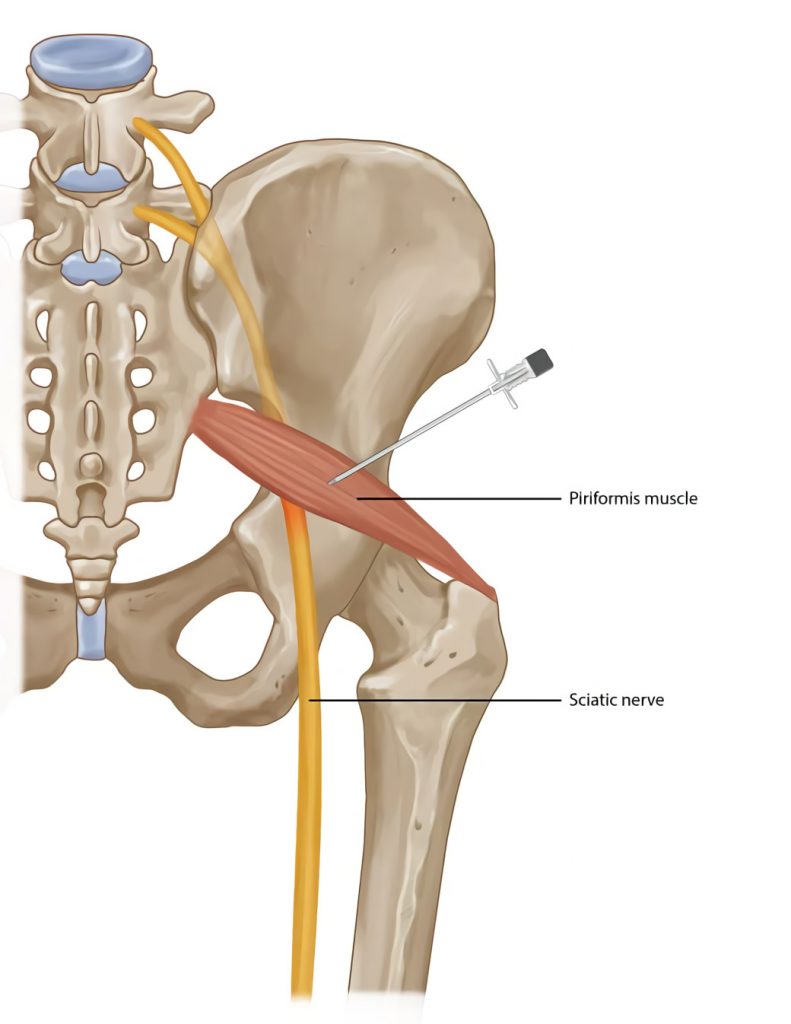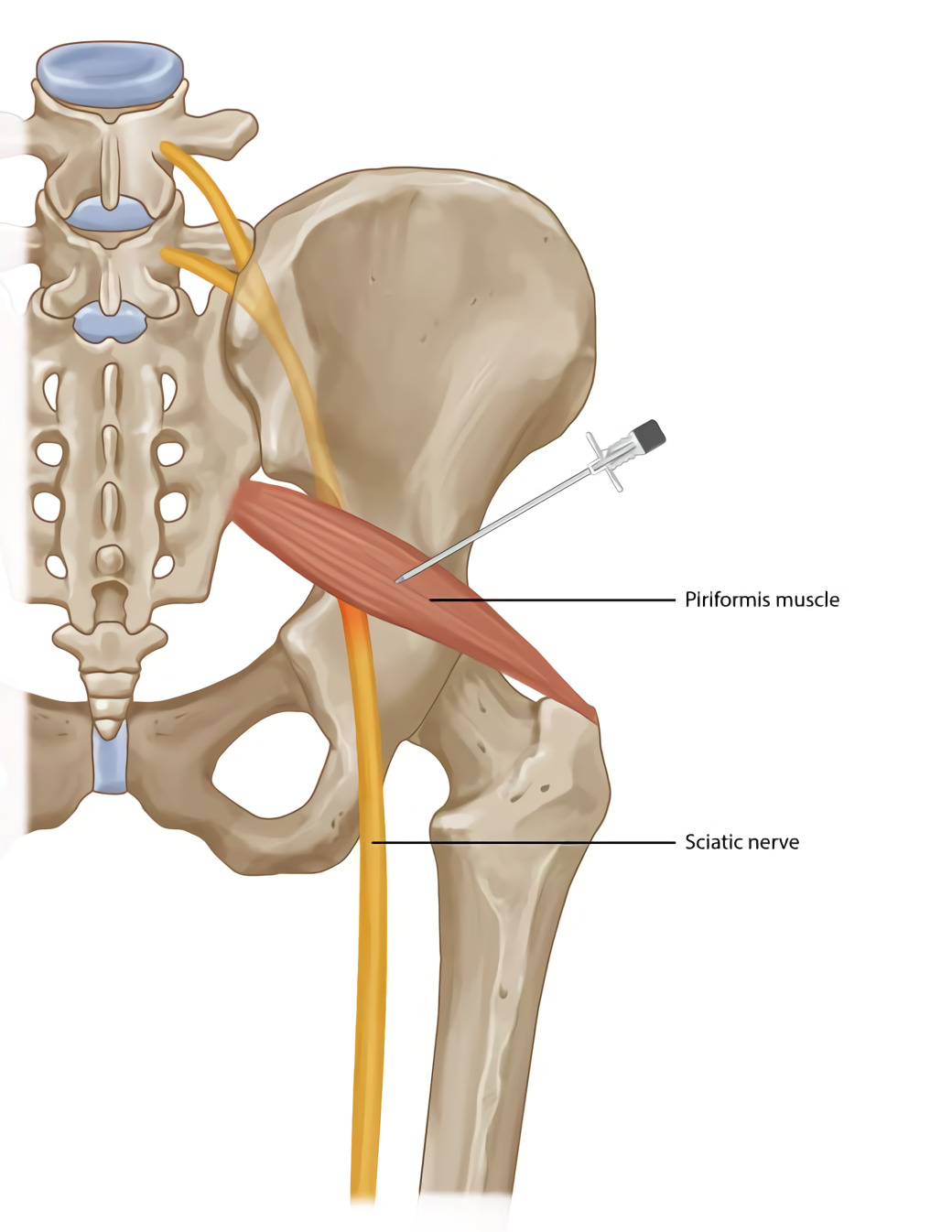Piriformis Syndrome
![]()
Call (703) 520-1031 or use the form to send us your contacts.
The piriformis muscle in the buttock area attaches the lowest vertebrae (sacrum) to the top of the femur or thigh bone on each side of the body. It passes through the pelvic bone (aka “sciatic notch” or greater sciatic foramen) along with the sciatic nerve. The proximity of the muscle and the sciatic nerve sometimes leads to piriformis syndrome, a neuromuscular condition. The following sections discuss various aspects of piriformis syndrome, from symptoms to treatment.

What is Piriformis Syndrome?
The flat piriformis muscle plays an important role in the movement of the lower body. It stabilizes the hip joint and enables rotation of the thigh away from the body. This enables you to walk, maintain balance, rotate and lift the thighs, shift body weight from one foot to another and perform other lower-body movements. It even enables you to place an ankle on the opposite knee while in a sitting position.
The closeness of the muscle and sciatic nerve can cause trouble sometimes. Per statistics published on the National Center for Biotechnology Information, U.S. National Library of Medicine, approximately .3 to 6-percent of all sciatica cases are actually piriformis syndrome. The sciatic nerve runs from the lower back and into the hips and buttocks and then down each leg. Sciatica is nerve pain that originates in the lower back and radiates down into the legs due to compression or irritation of the sciatic nerve.
Piriformis syndrome is a neuromuscular condition in which the piriformis muscle inflames or compresses the sciatic nerve. In approximately 22-percent of the population, the sciatic nerve runs right through the piriformis muscle instead of alongside it. There are also cases in which the sciatic nerve splits. One nerve branch goes through the muscle, and the other nerve branch runs along with the muscle. These people have a predisposition to piriformis syndrome.
Causes of Piriformis Syndrome
The causes of piriformis syndrome are usually:
- Piriformis muscle injury
- Abnormal location of the sciatic nerve (described in an earlier section)
- Sitting for long periods of time
- Vigorous exercise, sports activities or movements at work that repeatedly stress the piriformis muscle
- Diseases and conditions, like scoliosis or different leg-lengths
In many cases, the specific cause of this medical condition cannot be identified.
Piriformis Syndrome Symptoms
There are a variety of symptoms associated with piriformis syndrome, but piriformis pain is always eventually involved due to the inflamed or irritated sciatic nerve. The earliest signs may show up as numbness or tingling in the buttocks, but the pain will eventually develop.
Symptoms include:
- Buttock pain
- Butt pain from sitting for a prolonged period of time
- Pain in the buttocks that gets worse when moving the hips
- Severe pain that runs along the length of the sciatic nerve
- Pain triggered by activities like sitting, running, and climbing stairs
- Muscle spasms of the piriformis muscle
Diagnosis of Piriformis Syndrome
Piriformis syndrome is not common when compared to other types of medical conditions, causing back pain. Piriformis syndrome is often misdiagnosed because there is no medical test that pinpoints the condition, and the piriformis pain is similar to that experienced with other medical conditions, like sciatica. To diagnose this condition, the physician may order an MRI to rule out certain medical conditions and spine diseases, like a herniated disc or hip bursitis.
Since there is no specific blood test or imaging test that enables a definitive diagnosis, the doctor relies on assessing the symptoms and a physical exam. The physical exam mostly involves making the patient perform a variety of movements to see which ones cause pain in the piriformis muscle.
Treatment for Piriformis Syndrome
Piriformis syndrome treatment includes a variety of options. There is no single treatment. The doctor will make recommendations as to how to treat piriformis syndrome. It may take trying different things to see what works best for a particular situation. Various treatments can include a combination of more than one of the following:
- Stopping vigorous activities
- Applying ice and heat to the muscle
- Resting the muscle
- Massage
- Doing stretches and exercises
- Taking anti-inflammatory medications
- Taking muscle relaxants
- Getting a corticosteroid injection
- Getting a Botox injection (botulinum toxin)
- Osteopathic manipulative treatment (OMT) by an osteopathic physician
Surgery is recommended only in severe cases when nothing else works to relieve pain, and the condition does not improve.
FAQs
How to rest with piriformis syndrome?
Changing the way you sit and sleep is an excellent way to rest the muscle. You can sit with your knees straight, for example, so the hip and thigh is not rotated. Sit for only short periods. A good sleeping position is on your side with a pillow placed between the knees. General body rest is also helpful, but rest should be combined with gentle stretches and exercises.
What age can you get piriformis syndrome?
In most cases, piriformis syndrome develops in patients who are over 30 years old, but the more common age group is 40-50 years old. However, it can occur in younger adults due to trauma. Piriformis syndrome is much more common in women than in men.
How long does piriformis syndrome last?
Piriformis syndrome can last from several weeks to six weeks or longer. The length of time it takes to recover depends on the extent of the trauma to the muscle.
What is the main cause of piriformis syndrome?
The primary cause of piriformis syndrome is trauma to the buttocks that leads to inflammation of the soft tissue. The trauma could be an injury, overuse of the piriformis muscle, or direct compression (like sitting on hard surfaces for a prolonged period of time).
